Rembrandt and Mark Making
Rembrandt van Rijn (Dutch, 1606–1669) is generally considered one of the most important artists of the 17th century. In addition to his painting, Rembrandt was a master in the art of etching—a printmaking technique that involves drawing lines on a metal plate that has been treated with chemicals; once ink is applied to the plate, the incised lines hold the ink and form the image. Prints enabled artists such as Rembrandt to create multiples of their work in order to reach a larger audience. The Norton Simon’s collection includes more than 300 of his prints, including portraits, genre scenes, biblical scenes and landscapes. Here, we will examine Rembrandt’s mark making and the variety of ways in which he uses line in the etching Self-Portrait Leaning on a Stone Sill. The mark making in this print is primarily linear, and the techniques, for the most part, duplicate those used in an ink drawing.
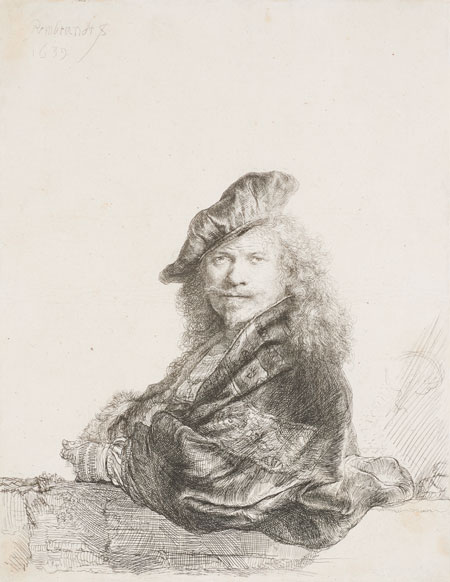
Rembrandt van Rijn (Dutch, 1606–1669), Self-Portrait Leaning on a Stone Sill, 1639, Norton Simon Art Foundation
Hatching
Hatching is a technique for creating tonal value (areas of varying degrees of darkness or lightness) through closely spaced parallel lines. The darkness of these tonal values may be changed by varying the width of the lines, the value of the lines and/or the space between the lines. Hatching is the basis for most mark making in an ink drawing, line etching, engraving or woodcut print. Hatched lines do not need to be straight lines. Artists might bend or curve the lines to follow the three-dimensional volume of the form they are describing.
Straight hatching
Curved hatching
Curved cross-hatching
Cross-hatching
With cross-hatching, the hatched lines intersect each other at an angle. Cross-hatching is used to increase the darkness of the tonal value and to help describe the form (or volume).
Hatching is not the only type of mark making we find in this etching; other marks will be explored below.
The Hat and the Cloak
In this print, the light is falling from the upper right, slightly in front of our subject. The hat is primarily etched with darker hatching that follows the contour of the material and the illumination of the light source. On the illuminated side of the cap are lighter lines moving horizontally and diagonally. Rembrandt has also added darker, cross-hatched lines for the shadowed side of the cap and the darkest occlusions (for example, the underside of the hat on the far left, just above the hair).
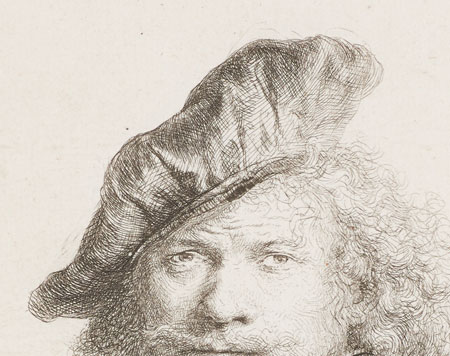
The rich cloak is treated in much the same way, with the lines used to describe both the value and the form of the material as it twists, stretches and folds. Rembrandt has also varied the value by altering the density of the lines, in order to account for the change in local value of the material (for example, the shirt is lighter in value than the cloak).
Along the edge of the lapels of the cloak we find a saw-toothed or zigzagging line that describes the texture of fur. Above his left hand we find curving, somewhat parallel lines also describing fur, but in a different manner.
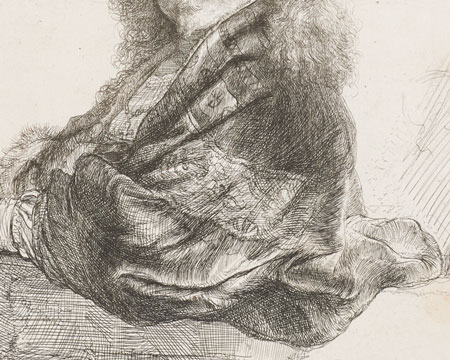
The Artist’s Head
On the artist’s face, we find a variety of marks to describe the form and the effect of light. The lines on the illuminated side are lighter in value and are spaced more widely. When we examine the transition of these lines into the highest value areas, we see that Rembrandt uses smaller, almost dot-like marks to create a gentle transition between his lines and the unprinted paper. Most of the lines on the face are curving, following the form of the head. We do find some straight lines, and these are generally used in the darker shadows (for example, on his forehead under his cap and to the left of the nose). For the darker values of the shadows, Rembrandt has used darker lines that are much closer together.
Rembrandt’s hair is curly, and to draw this, he has used an assortment of circling, curly lines. The density of these lines is built up to describe the effect of light. At the far right, on the illuminated side, the lines are light in value, and the artist has been careful to show the texture of the hair against the light background. On this same side of his face, the lines are built up, with the addition of cross-hatching, to indicate the darker occlusion where the hair meets the head.
For the hair on the left side of Rembrandt’s head, slightly darker lines are built up to describe the hair in shadow. Rembrandt has carefully portrayed the edge and texture of the shadowed hair against the background. For the deepest occlusion, under his jaw and against the side of his face, Rembrandt has again used cross-hatching through a series of lines parallel to the contour of his head, intersected by a series perpendicular to that contour.
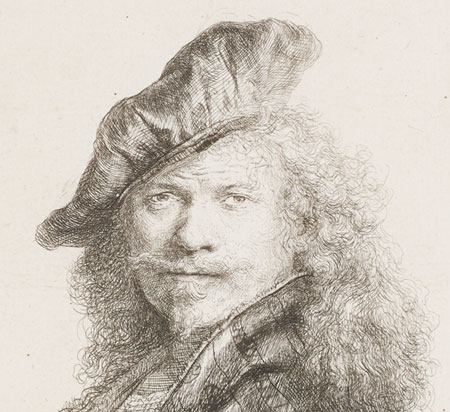
The Stone Sill
For the stone sill, Rembrandt has taken a slightly different approach. Here we find straight lines to describe the flat plane of the sill and the blocks used to make it. These are darker and slightly rougher lines, spaced farther apart, to indicate the rough texture of the stone. Within these lines we also find almost randomly curling or zigzagging lines to further show the texture (this may be most clearly seen on the far left side of the sill).
Although this etching is primarily linear, what we see is the play of light over the form of the artist as well as the individual textures of the materials. We perceive the light reflecting on his velvet hat, the softness of his skin, the curliness of the flowing hair that he proudly displays and the luxurious folds of his cloak as he leans his elbow over a rough stone sill.
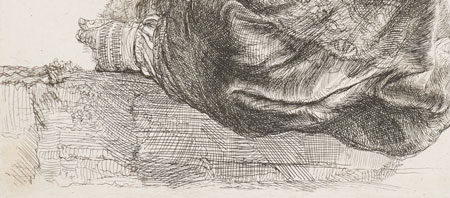
Drawing Exercises
- Practice drawing a series of straight and curved hatched lines. With regular practice, your ability to draw consistent lines will improve.
- Practice cross-hatching with both straight and curved lines. Explore how you can create darker values by increasing the density of the cross-hatched lines overlapping each other.
- Try drawing simple forms and objects with the linear techniques we have examined (for example, a ball, a box, a cup).
- As your skills improve, try making your own copy of Rembrandt’s Self-Portrait Leaning on a Stone Sill.
Suggested Materials
Any drawing medium that can produce a fine, precise line on paper is suitable for exploring these techniques, including sharpened graphite, pens or even digital media.
A Note on Etching
Etching is a form of intaglio printmaking in which the lines appear below the surface of the copperplate. First, the plate is coated with an acid-resistant ground. The artist draws a design into this ground using a finely pointed tool that exposes the plate. The plate is placed in an acid bath, where the exposed design is eaten away by the acid, or “etched.” When the artist is satisfied with the design on the plate, the ground is removed. The plate is inked and then carefully wiped, so that ink remains in the bitten lines of the plate but the surface of the plate is clean. The plate is then covered with a piece of damp paper and run through a printing press at very high pressure, forcing the paper fibers into the inked lines of the plate to reproduce the design on the finished print.
Lesson by teacher and artist Richard Houston
